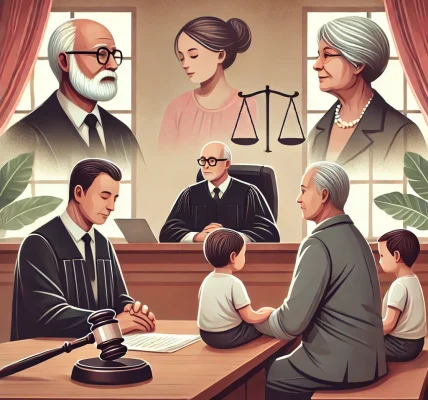Adoption is a life-changing legal process that establishes a permanent parent-child relationship between individuals who are not biologically related. Whether you are considering adopting a child or giving a child up for adoption, understanding the legal framework and procedures is crucial. This guide provides a detailed, legally safe, and SEO-friendly overview of the adoption process.
What is Adoption?
Adoption is the legal act of permanently transferring parental rights and responsibilities from a child’s biological parents to adoptive parents. Once finalized, the adoptive parents gain full legal custody, and the adopted child has the same rights as a biological child, including inheritance rights.
Adoption laws vary by country and state, so it’s essential to understand the legal requirements in your jurisdiction before proceeding.
Types of Adoption
There are several types of adoption, each with its own legal procedures and requirements. The most common types include:
1. Domestic Adoption
- The adoption occurs within the same country.
- Can be facilitated through private agencies, state agencies, or independent adoptions.
2. International Adoption
- Involves adopting a child from a foreign country.
- Requires compliance with both the child’s home country laws and the adoptive parents’ country laws.
- May require travel, immigration processes, and extended waiting periods.
3. Stepparent Adoption
- A stepparent legally adopts their spouse’s child.
- The noncustodial biological parent’s rights must be terminated (voluntarily or through court intervention).
4. Foster Care Adoption
- Involves adopting a child who has been in the foster care system.
- Often occurs when a child’s biological parents’ rights are terminated due to neglect, abuse, or abandonment.
- Typically a more affordable option with government assistance available.
5. Relative (Kinship) Adoption
- A family member (grandparent, aunt, uncle, etc.) adopts the child.
- Usually occurs when biological parents are unable to care for the child.
6. Open vs. Closed Adoption
- Open Adoption: Allows contact between the adoptive family and biological parents, depending on the agreement.
- Closed Adoption: No contact between biological parents and the adoptive family after finalization.
Legal Requirements for Adoption
Before proceeding with adoption, prospective adoptive parents must meet certain legal requirements, which may include:
- Minimum age requirement (varies by state/country, typically 18–25 years old)
- Stable financial status and ability to provide for a child
- Home study evaluation (social workers assess home environment, lifestyle, and parenting readiness)
- Background checks (criminal history and child abuse clearances)
- Completion of parenting or adoption education programs (if required by the state/country)
Step-by-Step Legal Adoption Process
The adoption process involves multiple legal steps to ensure the child’s best interests are protected. Below is a general outline of the legal adoption process:
Step 1: Decide on the Type of Adoption
- Choose between domestic, international, stepparent, foster care, or relative adoption.
- Research adoption agencies, attorneys, or government agencies that handle adoptions.
Step 2: Meet the Legal Eligibility Requirements
- Complete necessary background checks and financial evaluations.
- Undergo home study assessments by licensed social workers.
Step 3: Identify and Match with a Child
- If adopting through an agency, work with social workers to find a child that matches your criteria.
- In cases of private adoption, biological parents may choose the adoptive family.
Step 4: Obtain Parental Consent and Termination of Parental Rights
- Biological parents must voluntarily relinquish their parental rights, or the court may terminate them due to abandonment, neglect, or abuse.
- In stepparent or relative adoptions, the noncustodial parent’s rights must be terminated.
Step 5: File the Adoption Petition in Court
- The adoptive parents must file a formal petition with the family court.
- The petition includes:
- The adoptive parents’ details
- Child’s background
- Consent documentation (if applicable)
- Home study report
- Reasons for seeking adoption
Step 6: Attend Court Hearings
- A judge will review the adoption petition and assess whether the adoption serves the child’s best interests.
- The adoptive parents may need to testify or answer questions about their intentions and ability to care for the child.
- The court may grant an interim custody order before finalizing the adoption.
Step 7: Adoption Finalization
- If approved, the court issues an Adoption Decree, granting the adoptive parents full parental rights.
- A new birth certificate is issued, listing the adoptive parents as the child’s legal parents.
Rights and Responsibilities of Adoptive Parents
Once the adoption is finalized, adoptive parents assume full legal responsibilities, including:
- Providing for the child’s physical, emotional, and educational needs.
- Granting inheritance rights equal to biological children.
- Following any agreements regarding open adoption contact (if applicable).
Legal Challenges in Adoption
While adoption is a rewarding process, legal challenges may arise, such as:
- Contested Adoptions: A biological parent may revoke consent or challenge the adoption in court.
- Fraud or Misrepresentation: False information provided during the adoption process can lead to legal complications.
- Interstate or International Laws: Different legal requirements for out-of-state or international adoptions may cause delays.
- Adoption Disruptions: In rare cases, adoptions may be disrupted if the biological parents or courts reverse decisions before finalization.
Post-Adoption Legal Considerations
After the adoption is finalized, adoptive families should take additional legal steps, including:
- Updating the child’s legal documents (Social Security, passport, etc.).
- Changing the child’s last name (if desired).
- Ensuring compliance with any post-adoption agreements.
- Applying for adoption-related benefits or financial assistance programs (if applicable).
Conclusion
The adoption process is legally complex but ultimately rewarding for both the child and the adoptive parents. Understanding the step-by-step legal requirements and challenges can help prospective adoptive families navigate the process smoothly.
Whether adopting domestically or internationally, working with a qualified adoption attorney or licensed agency ensures legal compliance and a successful adoption journey. If you’re considering adoption, researching state laws and seeking professional guidance will help protect your rights and the best interests of the child.
By staying informed and prepared, adoptive families can create a loving, legally secure home for their new child.




